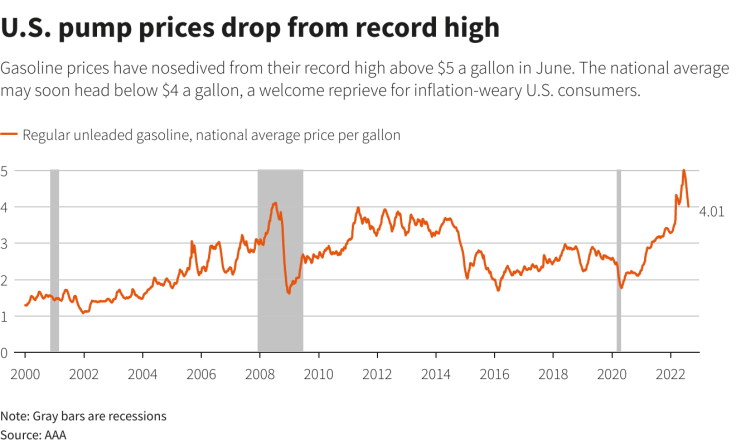U.S. Consumer Price Growth Expected To Slow Due To Lower Gasoline Costs
U.S. consumer prices are expected to have risen at a much slower pace in July due to a sharp drop in the cost of gasoline, delivering the first notable sign of relief for Americans who have watched inflation climb over the past two years.
The Consumer Price Index (CPI) likely rose 0.2% last month after advancing 1.3% in June, according to economists polled by Reuters ahead of the release of the closely-watched Labor Department report on Wednesday.
That would be the largest month-on-month deceleration of price increases since 2005 and follow on the heels of a roughly 20% drop in the cost of gasoline. Prices at the pump spiked in the first half of this year due to the war in Ukraine, hitting a record-high average of more than $5 per gallon in mid-June, according to motorist advocacy group AAA.
The report, however, is still likely to show that underlying inflation pressures remain elevated as the Federal Reserve mulls whether to embrace another super-sized interest rate hike in September.
The Fed has indicated that several monthly declines in CPI growth would be needed before it lets up on the aggressive monetary policy tightening it has delivered to tame inflation currently running at a four-decade high.
U.S. pump prices drop from record high:

U.S. consumer prices have been surging due to a number of factors, including snarled global supply chains, massive government stimulus early in the COVID-19 pandemic and Russia's invasion of Ukraine.
Food is one component of the CPI that is expected to remain elevated in July.
"Overall year-over-year changes in consumer prices are well above target and are likely to remain high enough over coming months to keep rates firmly on an upward trajectory," said Rubeela Farooqi, chief U.S. economist at High Frequency Economics.
In the 12 months through July, the CPI is seen increasing by 8.7% following a 9.1% rise in June, according to the Reuters poll, which would be the largest slowdown in annual inflation since April 2020. But underlying inflation pressures, which exclude volatile food and energy components, are set to remain strong.
While the so-called core CPI is forecast to be up 0.5% in July after climbing 0.7% in June, it is expected to increase 6.1% in the 12 months through July. That would follow a 5.9% rise in the 12 months through June.
Inflation in the cost of rent and owners' equivalent rent of primary residence, which is what a homeowner would receive from renting a home, is likely to have held steady last month. Shelter costs comprise about 40% of the core CPI measure.
"Among the most persistent forms of inflation is rental inflation ... given that it takes time for spot rental rates to filter through to the stock of rented units, we expect that CPI rental inflation was very firm last month," said Michael Feroli, chief U.S. economist at J.P. Morgan, which forecasts 0.7% monthly gains for both of those categories.
TIGHT LABOR MARKET
Whether the Fed will go ahead with a third straight 75-basis-point rate hike at its Sept. 20-21 policy meeting, a pace unmatched in more than a generation, or dial back a bit is of central interest to investors, businesses and consumers.
Fed policymakers last week flagged that they will push on with the rate hikes until they see strong and long-lasting evidence that inflation is on track back down to the U.S. central bank's 2% goal.
Inflation set to ease, but by how much?:

An extremely tight labor market also is driving up wages that in turn contribute to higher prices for services. Most inflation pressures until recently had been concentrated in goods, and Fed policymakers are fearful that accelerating service-sector inflation will be more difficult to unravel.
There may be little relief on that front in light of the stronger-than-expected job growth and wage gains in July. The economy created 528,000 jobs last month and the unemployment rate fell back to its pre-pandemic low, the government reported on Friday.
Labor market tightness is also underscored by the fact that, although U.S. job openings fell to a nine-month low in June, there were still almost two jobs for every unemployed person.
The strength of the job market will make it harder for the Fed to bring the economy into balance soon.
Financial markets currently expect the central bank to raise its benchmark overnight interest rate, last set in a target range of 2.25% to 2.50%, by another three-quarters of a percentage point next month.
The Fed has hiked its policy rate by 225 basis points since March despite fears that the sharp rise in borrowing costs could tip the economy into recession.
© Copyright Thomson Reuters 2024. All rights reserved.




















